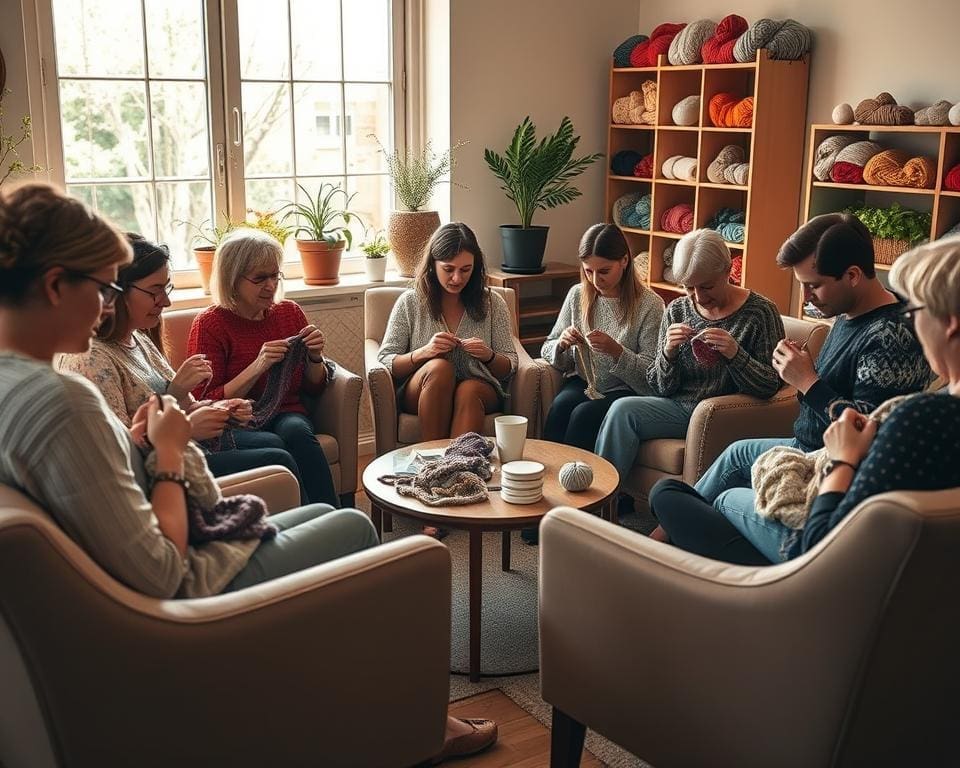In today’s fast-paced world, the quest for effective stress relief methods has become increasingly important. One intriguing and calming activity that has garnered attention is knitting, particularly within a group setting. Can knitting in a group lower stress levels? This article delves into the benefits of knitting in a group for stress reduction, exploring how this time-honoured craft can foster mindfulness and community connections. By engaging in group knitting, individuals not only indulge their creativity but also cultivate supportive relationships that significantly contribute to mental wellbeing.
Understanding Stress and Its Impact on Daily Life
Recognising the complexities of stress is crucial for maintaining a healthy lifestyle. Stress manifests as a blend of psychological and physiological responses triggered by perceived threats or challenges. The World Health Organisation underscores the significance of understanding stress, labelling it a leading cause of various health issues. Chronic stress can contribute to a myriad of conditions, emphasising the urgent need for stress reduction.
What is Stress?
Stress is an individual’s reaction to external pressures. It can range from mild discomfort to overwhelming feelings of anxiety and tension. The body responds to stress through physical changes, including increased heart rate and heightened alertness, which can be beneficial in short bursts. However, prolonged exposure leads to a decline in mental and physical health.
The Effects of Long-Term Stress
The effects of long-term stress are profound and life-altering. Continuous strain can result in chronic health problems, such as cardiovascular diseases and mental health disorders like anxiety and depression. These repercussions illustrate the importance of understanding stress mechanisms and the impact they have on daily life.
Why Stress Reduction is Essential
Addressing the need for stress reduction is fundamental to fostering overall well-being. Engaging in activities that mitigate stress not only improves mental clarity but also enhances physical health. Implementing effective stress management techniques can play an essential role in living a balanced life, paving the way for happier, more fulfilling experiences.

Can knitting in a group lower stress levels?
Engaging in group activities has shown significant potential in alleviating stress levels. The beauty of communal crafts, such as group knitting, lies in their ability to foster a sense of belonging while also providing creative outlets. Various studies have indicated that participation in such collaborative environments can directly enhance personal well-being and reduce anxiety.
Research and Studies on Group Activities
Research from institutions, including the University of Massachusetts, reveals an intriguing connection between group activities and lower anxiety levels. Participants in knitting circles often report feelings of happiness and reduced stress. The camaraderie developed during these sessions creates a supportive atmosphere, allowing individuals to share their experiences and challenges. Such interactions encourage emotional resilience and provide a platform for mutual encouragement.
The Psychological Benefits of Knitting
Knitting engages both the mind and body, resulting in remarkable psychological benefits of knitting. The repetitive motions involved in crafting can induce a meditative state, promoting tranquillity. As crafters focus on their stitches, they often experience a shift in awareness, distancing themselves from daily stressors. This kind of mindfulness is beneficial in enhancing cognitive focus, allowing individuals to be present and engaged in the moment, which serves as a powerful strategy for knitting for stress reduction.
Group Knitting Benefits for Mental Wellbeing
Engaging in group knitting offers remarkable advantages that extend far beyond the mere act of creating fabric. This activity showcases a twofold benefit, fostering vital social connections while simultaneously enhancing creativity and promoting stress relief. By coming together in a supportive environment, participants can combat feelings of isolation often experienced in today’s fast-paced world.
Fostering Social Connections and Community
The essence of group knitting lies in its ability to bring people together. As individuals share their techniques, patterns, and experiences, they form meaningful relationships. These social connections create a sense of belonging, enabling participants to feel valued and understood. The emotional warmth arising from these interactions contributes significantly to mental wellbeing, reinforcing the positive effects of community support. Friends often emerge from knitting circles, with bonds strengthening over each stitch shared, transforming a solitary task into a communal experience.
The Role of Creativity in Stress Relief
Knitting inherently allows for self-expression and fosters creativity. Each project serves as a canvas where crafters can explore their artistic side while reaping the stress-relieving benefits of being engrossed in a creative pursuit. The rhythmic movements of the needles and the tactile sensations of the yarn provide a calming effect. Creating something tangible stimulates not only the hands but also the mind, releasing endorphins that help alleviate tension. These group knitting benefits contribute to the development of a relaxed state, highlighting how engaging one’s creativity can serve as a powerful tool for mental enrichment.
Knitting Therapy: A Historical Perspective
Knitting therapy has journeyed through time, beginning as a functional craft and evolving into a well-respected therapeutic practice. Its historical perspective reveals how this skill has provided comfort and solace, becoming a recognised tool for promoting mental health. Across various eras, knitting has served not only practical purposes but also psychological ones, creating a sense of community and belonging.
How Knitting Became a Therapeutic Tool
The roots of knitting as a therapeutic tool can be traced back centuries. Initially, the craft was a means of production, providing essential items for families. As people recognised the calming effects of repetitive motions, its role shifted. Many began to explore the psychological benefits of knitting, identifying its power to alleviate stress and anxiety. Groups began forming, where individuals would gather to knit, share stories, and support one another, creating bonds that bolstered emotional resilience.
Modern Applications of Knitting Therapy
In contemporary society, the applications of knitting therapy have flourished. Initiatives like ‘Knit for Peace’ exemplify how knitting has been harnessed to support mental health recovery. These programmes engage individuals from various backgrounds, fostering social connections and providing a sense of purpose. Community centres and hospitals now incorporate knitting into their therapeutic offerings, recognising its potential to ease symptoms of depression and anxiety while enhancing overall well-being. The integration of knitting within modern therapeutic practices illustrates its timeless relevance in today’s world.
Stress Reduction Through Group Knitting
Engaging in knitting within a group setting offers a unique opportunity for stress reduction through group knitting. The collaborative nature of these activities fosters a sense of community that enhances relaxation. Group dynamics play a significant role in creating an environment that encourages members to share not only their craft but also their thoughts and feelings. This bonding experience can lead to a greater sense of belonging, which is essential for mental wellbeing.
How Group Dynamics Enhance Relaxation
Group dynamics can significantly influence how individuals experience relaxation during knitting sessions. When participants engage collectively, they mutually support one another, promoting a healing atmosphere. The exchange of ideas, laughter, and encouragement creates bonds that help dissipate stress. Psychological studies have shown that being part of a group can lead to a reduction in anxiety levels. This synergy among participants makes the knitting experience not just about the craft, but also about connection and mutual appreciation.
Personal Stories and Testimonials
Testimonials from individuals involved in group knitting activities highlight the profound impact these gatherings can have on mental health. Many have expressed feelings of rejuvenation and inspiration as a result of shared experiences. For instance, one participant noted,
“Knitting in a group has transformed my perspective. I feel more relaxed and connected to others.”
These personal stories showcase how stress reduction through group knitting not only helps with anxiety but also builds lasting friendships.
Group Knitting Activities for Stress Relief
Engaging in group knitting activities provides an uplifting escape from daily stresses. Knitting nurtures creativity while building connections with others. Across the UK, a variety of popular events and workshops cater to both seasoned knitters and beginners, fostering an inclusive environment. These gatherings cultivate friendships and enhance wellbeing through shared experiences.
Popular Group Knitting Events and Workshops
Many organisations promote group knitting activities. Local community centres and knitting groups hold regular sessions where enthusiasts gather to share their techniques and projects. Events like the ‘Great British Yarn Festival’ and ‘KnitFest’ offer opportunities to learn new skills while enjoying the camaraderie of fellow knitters. Participation in these events can transform a solitary hobby into a vibrant social experience.
Online vs. In-Person Group Knitting
The rise of online knitting communities complements traditional meet-ups. Virtual platforms enable knitters from various locations to connect, share patterns, and support each other’s projects. While online interactions are beneficial, face-to-face gatherings often provide a deeper sense of community and motivation. Both formats hold value, with many knitters participating in a blend of online vs in-person group knitting activities to meet their social and creative needs.
Knitting as a Stress Management Tool
As we delve into the multifaceted world of stress management, it becomes increasingly clear that knitting serves as a remarkably effective tool. The combination of tactile engagement and mindful focus allows individuals to navigate their stress levels more effectively. Engaging in this craft not only fosters creativity but also promotes a reflective state of mind, providing a natural antidote to the pressures of daily life.
Participating in group knitting sessions amplifies these benefits by incorporating social interaction, which is crucial for emotional wellbeing. When individuals gather to knit, they cultivate a sense of community that enhances the stress management experience. The shared moments of laughter, learning, and support create an environment where relaxation flourishes, making knitting not just an individual pursuit but a collective journey towards lower stress levels.
Ultimately, embracing knitting as a stress management tool is an invitation to prioritise self-care and wellbeing. Whether knitting alone or among friends, each stitch serves as a reminder that simple pleasures can significantly impact our mental health. So, pick up those needles, and let the rhythm of your craft guide you towards a calmer, more centred self—one beautiful creation at a time.









